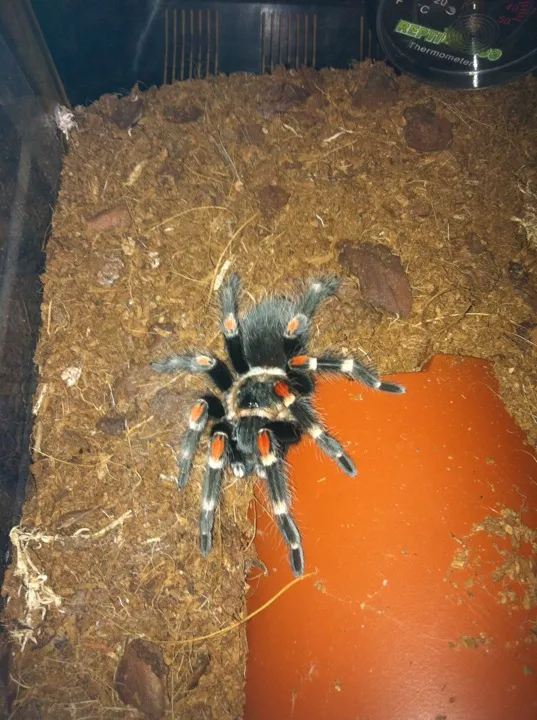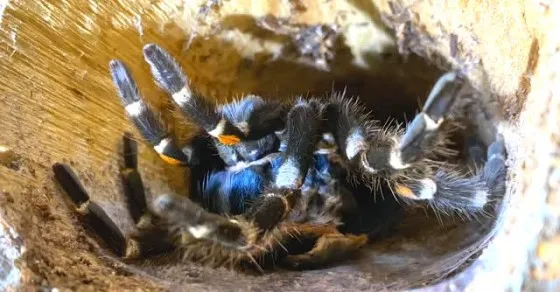Understanding Mexican Flame Knee Tarantula Molting
Molting is a fundamental biological process for all tarantulas, including the vibrant Mexican Flame Knee (Brachypelma auratum). It is essentially the shedding of their exoskeleton, or outer shell, allowing the tarantula to grow and regenerate damaged body parts. This process is crucial for their survival and overall health. During molting, the tarantula creates a new, larger exoskeleton underneath the old one. When the time is right, it will shed the old one, revealing the new, soft body. This is a vulnerable time for the tarantula, as it is soft and defenseless. Understanding this process is key to providing the right care for your pet tarantula.
What Triggers Molting in Mexican Flame Knee Tarantulas
Several factors can trigger the molting process in Mexican Flame Knee tarantulas. The primary driver is growth; as the tarantula gets bigger, it outgrows its exoskeleton. The frequency of molting depends on the tarantula’s age and growth rate. Spiderlings molt much more frequently than adults. Other factors like sufficient nutrition and environmental conditions also play a role. A healthy tarantula that is well-fed and living in a suitable environment is more likely to molt successfully. Stress, such as improper temperature or humidity, can sometimes delay or disrupt the molting process. Ensuring optimal living conditions is the best way to support your tarantula’s molting cycle.
How to Prepare for Molting [Essential Steps]

Preparing for a molt is crucial for the health and safety of your Mexican Flame Knee tarantula. Before a molt, the tarantula will often stop eating and may become less active. It is important to provide a safe and undisturbed environment. Remove any uneaten prey items to prevent them from bothering the tarantula during its vulnerable state. Keep the enclosure clean and maintain appropriate humidity levels. Avoid handling or disturbing the tarantula during this time. Providing a shallow water dish is also essential for hydration. Preparing your tarantula’s enclosure will help ensure a successful and stress-free molt.
Creating the Ideal Environment for Molting
Creating a suitable environment is paramount for a successful molt. The enclosure should be large enough for the tarantula to move around comfortably, with plenty of substrate for burrowing if the species is inclined to do so. Provide a hide or shelter where the tarantula can retreat and feel secure. Maintaining the correct humidity and temperature levels is also essential. A stable environment minimizes stress and promotes a healthy molting process. Ensure the enclosure is free from any hazards that could injure the tarantula during the molt, such as sharp objects or loose decorations. A well-prepared environment significantly increases the chances of a successful molt.
Humidity and Temperature Control [Key Factors]
Humidity and temperature are critical factors in the molting process. Mexican Flame Knee tarantulas thrive in a specific range of both. Humidity helps the tarantula shed its old exoskeleton, while the right temperature ensures that the tarantula’s metabolism functions properly. Regularly monitor the humidity levels using a hygrometer, and adjust as needed by misting the enclosure or improving ventilation. Temperatures should be maintained within a suitable range, using a heat source such as a heat mat. Avoid placing the heat source directly under the enclosure. Fluctuations in temperature and humidity can stress the tarantula and potentially lead to molting problems. Consistent monitoring is crucial for promoting a successful molt.
Feeding Your Tarantula Before and After Molting

The feeding routine must be adjusted to support molting. Before molting, the tarantula will typically lose its appetite and refuse food. Do not force-feed; this is a natural part of the process. After the molt, the tarantula’s fangs and exoskeleton will be soft, and it will not be able to eat immediately. Wait a few days before offering food. The time frame depends on the size and the age of the tarantula. Start with smaller prey items to prevent injury. Providing a balanced diet of appropriately sized insects, such as crickets or roaches, will help the tarantula regain its strength and rebuild its new exoskeleton. Ensure fresh water is always available for drinking after the molt.
Signs Your Mexican Flame Knee Tarantula Is About to Molt
Recognizing the signs that your Mexican Flame Knee tarantula is about to molt can help you prepare and provide the best care. The tarantula might become less active, spending more time in its hide or burrow. It may stop eating for several weeks or even months. The abdomen may appear darker or swollen. Some tarantulas may also start to build a web mat, which is the pre-molt behavior to protect itself. Look for these signs to adjust your care routine accordingly. Being attentive to your tarantula’s behavior is essential for ensuring a smooth and safe molting experience.
Recognizing a Successful Molt
Identifying a successful molt is essential. After the molt, the tarantula will leave behind its old exoskeleton. The new exoskeleton will be brighter in color. The tarantula’s fangs and body parts should be in perfect condition. Examine the discarded exoskeleton to ensure all legs and other body parts are present. A successful molt indicates that the tarantula has grown and renewed its outer shell without any problems. If you notice any missing limbs or damage on the old exoskeleton, consult a veterinarian or experienced tarantula keeper for advice.
Troubleshooting Common Molting Problems

Sometimes, molting can be a challenge. Common problems include the tarantula getting stuck in its old exoskeleton, or losing a leg during the process. If your tarantula is struggling to molt, do not attempt to remove the old exoskeleton yourself, as this can cause serious injury. Ensure the enclosure has appropriate humidity. Seek guidance from an experienced tarantula keeper or veterinarian if you encounter any molting problems. Providing the right environment and knowing what to do can improve the chances of a healthy molt. Avoid unnecessary interventions and consult experts when problems arise.
How to Handle a Recent Molt
After a successful molt, avoid handling your tarantula for several days. The new exoskeleton is still soft and vulnerable. Give your tarantula time to harden its new shell before resuming regular handling. Provide fresh water and a clean enclosure. Offer food once the fangs have hardened. Always use gentle handling techniques and be patient. By giving your tarantula time to recover and adjust, you can avoid causing stress or injury. Handling can be done after a week from the molt, when the exoskeleton becomes harder. Observe your tarantula’s behavior to ensure it is ready for interaction.
